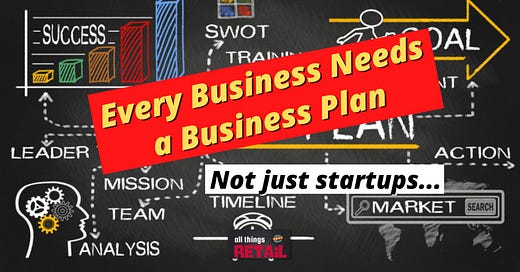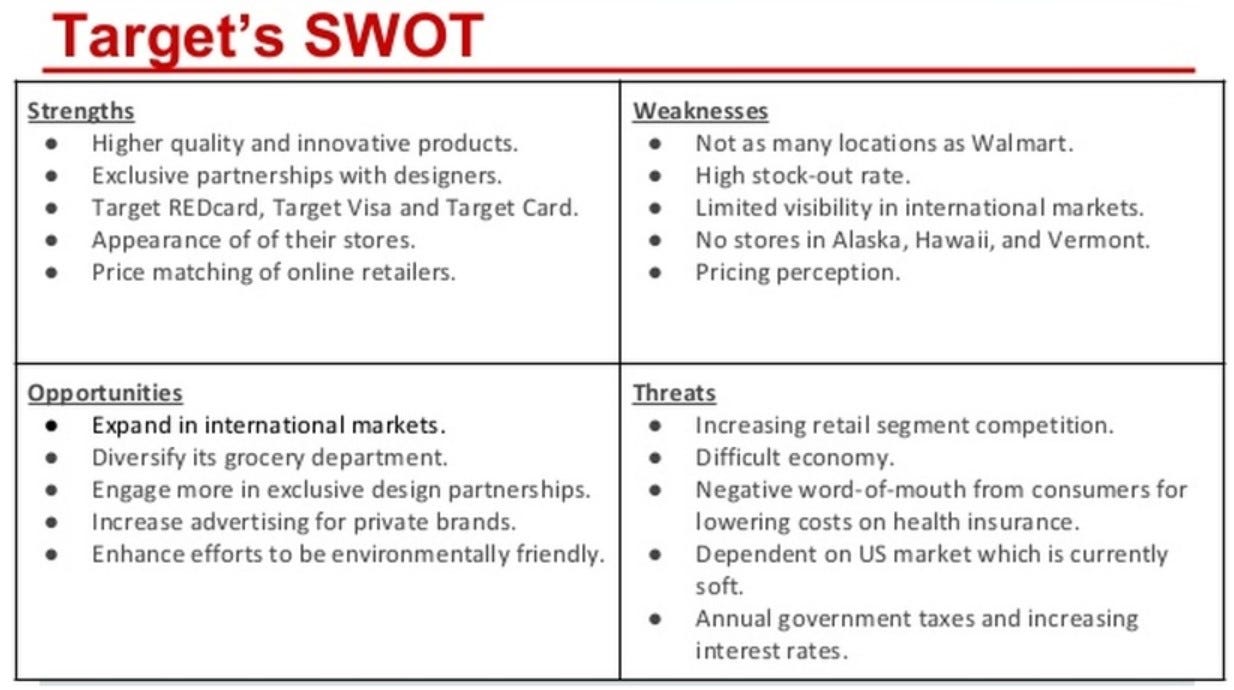Every Retail Business Needs a Business Plan. This Means You!
Proceed without a plan at your own peril...I have seen it happen way too many times!
Plan your work and work your plan! This was taught to me many years ago and rings just as true today as it did then. Regardless if you want to call it a business plan, strategic plan, or something different, you need a plan for your business that is updated annually and utilized throughout the year. Otherwise there is a reasonable likelihood that your business will simply move in a fairly rudderless fashion. Create a plan, act on it, pivot if necessary, but keep moving forward. Read on for more…
Business plans are not just for startups. I know when you think about a business plan, your mind often goes to launching a business, raising, capital and other startup related initiatives. That’s normal. But after developing several business plans and launching the related businesses (both for clients and a few of my own), I have developed the belief that they are powerful tools for companies of all ages!
Let me explain.
In my mind, business plans not only force you to “plan” your business for the next 12-36 months (the classic 5-year plan is a waste as the out years become wishful thinking rather than a logic-based forecast), but they go deeper by insisting that you to think about essentially every element of your business in great detail.
A typical annual plan (IF you do one at all) focuses on what you want to do, without necessarily digging in to every area of the operation to determine if there are more important priorities. Said differently, an annual strategic plan is often a “top down” plan which may omit key business needs, whereas a business plan approach is “bottom up” where you need to consider all of the elements of the business.
The bottom up approach may identify key priorities which otherwise could be missed and, possibly of greater importance, it will force you to think about aspects of your operation you might otherwise ignore (“too difficult to address, “you don’t know how to improve it”, “it’s not as much fun”, etc.).
This theory led me to move away from traditional strategic planning tools many years ago in favor of creating an updated business plan for the upcoming 1-2 years.
Creating a business plan-like version of your annual strategic plan will:
Help identify any weaknesses in your business model. Sales, margin, expenses, go-to-market tactics, marketing, product, pricing, operations, team building, real estate, etc.
Document the working capital necessary to operate the business and execute your plan while providing a reasonable “cash cushion”.
Identify business growth opportunities you may not have identified previously and plan how to leverage them.
Analyze the current state of the market and your competition to strengthen your business positioning.
Evaluate your target customer and determine if adjustments need to be made.
Force you to identify potential business risks and plan contingency strategies for addressing them.
Allow you to demonstrate to your team, investors, bankers, and more that you are serious about your business and you have a meaningful understanding of the detailed status of the operation and a related plan on how to effectively move forward.
Laying out a detailed, step-by-step plan gives you a blueprint you will utilize throughout the year and keeps your entire team aligned on your business priorities.
“So, what should I include in the plan??”
Company Description.
I know you think you know how to describe your business. But take a step back and reevaluate if that description is as appropriate as it should / could be. Does it truly reflect how you want people to view your business? What is your reason to exist? What makes you special? Why do (or should) customers come to you instead of shopping at your competition?
Who is Your Target Customer & What is Your Target Market?
Trying to appeal to everyone, while enticing on the surface, is a flawed strategy. It’s important that you have clarity on the market and the consumer you want to serve. It will allow you to focus your efforts and maintain consistency in your branding, product offering, marketing efforts and more. As you analyze past performance, this exercise will also allow you to better understand the characteristics (age, location, gender, income and education levels, marital status, etc.) of your most profitable customers (not every customer add the same value to your business) and adjust your business development tactics accordingly. Here is a bit more info on how to identify your target market.
Update Your Industry Analysis and Industry Segment.
While nothing may have changed (unlikely in this day and age), it’s best to vet this to ensure your are staying current with trends, offerings, and tactics related to your specific industry. Don’t think “retail” as a marco industry but think “pet supply retail” or “teen apparel and accessory retail”. An industry analysis is a qualitative and quantitative assessment of your specific retail market. What are the current trends in retail (BOPIS, omnichannel, sustainability, metaverse for example)? What’s selling and what’s not? What trends are you seeing for specific products and categories?
Perform a Competitor Analysis.
You need to have a robust understanding of your competitors and how they operate and sell. While I have always been a believer that companies should focus first and foremost on providing consumers great products and a great experience, ignoring the competition is simply short sighted. Take a deep dive into how your competitors fit into the market. Look at physical merchants as well as online sellers.
Can you identify their annual revenue and growth pattern?
Which channels are they selling through (physical, website, Amazon, Facebook, Instagram, etc.)?
What value-add services do they offer (shipping, delivery, BOPIS, personalized shopping, rewards program, etc.)?
Are they adding locations and will those impact your trade areas?
What is their pricing strategy? Do they discount? If so, can you identify a discount pattern?
Does my competitor have a partnerships with other businesses? What other forms on non-traditional marketing and selling do they use?
Define Your Product Strategy.
What do you sell and why do you sell it? Be specific. Using the pet store example, don’t just list “pet food”. For dogs? Cats? Birds? All? Is the food mass appeal? Healthy and nutritious? Organic? What other offerings do you have any why? How does all of this tie back to your target market/customer? How will all of these products be priced? Do all current categories warrant being carried on a go-forward basis?
Then shift into the operational side of your product offering. Will you source products domestically, internationally or both? What are your margin expectations? How will inventory and replenishment be managed? Can you improve your turns? What will your promotional strategy be?
Again, the purpose of approaching all of this from a quasi-zero base will force you to analyze and think about critical elements of your business that you may otherwise take for granted.
Define Your Marketing Strategy.
The earlier sections of your business plan will provide the detail to create or update a positioning statement for your business. This simply details how you want the outside world to perceive your brand. What is your core offering? How would you describe your competitive advantages (“value proposition”)? Why do customers choose your business over others and why will they continue to do so? This positioning statement will then become the basis for your marketing strategy. Who will you target? How will you reach your consumer (which mediums)? How much will you spend in total and how will you segment that spend? How will you track results and define success? Will you test new marketing tactics?
Review Your Operations.
Expense structure: determine if your historical expense structure is appropriate for your business going forward. Identify opportunities to reduce spending where it’s not contributing to the bottom line. Conversely, consider areas where additional investments may result is disproportionately positive results.
People: attracting and retaining great people is more challenging than ever. Beyond utilizing my advice from prior issues of All Things Retail, what else will you do to build a world class retail team and keep them? It’s critical to think about this in great detail and include specifics in your go-forward plan.
Supply chain: we all know the supply chain issues that occurred in 2021 and are continuing into early 2022. You need to continue to develop a perspective on how you’ll plan and control ordering inventory (possibly with extended lead times), how and where you will store it, and ultimately replenish it to stores or ship directly to your customers.
Merchandising: once the goods arrive at your store(s), you need a plan on how to sell them quickly and ideally within your margin plan. Location, space allocation, graphic support, impulse merchandising, sale events, “endless aisle” (online access / omnichannel) functionality, and more. Is your current merchandising configuration as effective as it could be? Going through this process will help you answer that question.
Technology: you are probably comfortable with your current tech stack and it may be perfectly fine. Nonetheless, I suggest you consider a few points to determine if upgrades may be needed. Is your customer throughput as fast as you would like? Can you add self-checkout if desired? Are hand-held options available to support omnichannel? Does your system support services like BOPIS, delivery, shipping, subscriptions, rewards membership? Does the system integrate well with your financial software? Your plan should touch on why you are OK with your current tech stack or how you see it evolving over the coming year.
Real estate: are you considering adding new locations in the next 24 months? If so, you need to begin planning for that 12-18 months in advance (or a few months for pop-ups…ask me for more info on why). If unit growth is in your future, where will it occur? What markets? What location criteria such as population, demographics, location type, competition, etc? What size store? Do you need an updated design? What are you will pay for occupancy and buildout? How long is the payback period? Conversely, do you have leases expiring in the next 12-24 months and if so, what’s the plan for renewal, relocation, or closure?
Complete Your Financial Plan Using All the Info Above.
Here is where you update and finalize your forecast income statement, balance sheet, and cash flow planner. I have written about each of these critical tools previously (click the links), but want to stress that the assumptions that you put into your financial docs should reflect the go-forward elements of your business plan.
Build a SWOT Analysis.
Keep reading with a 7-day free trial
Subscribe to All Things Retail to keep reading this post and get 7 days of free access to the full post archives.






